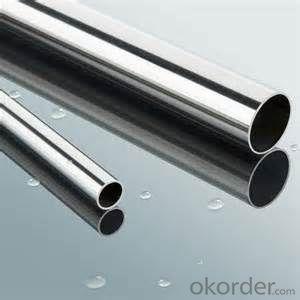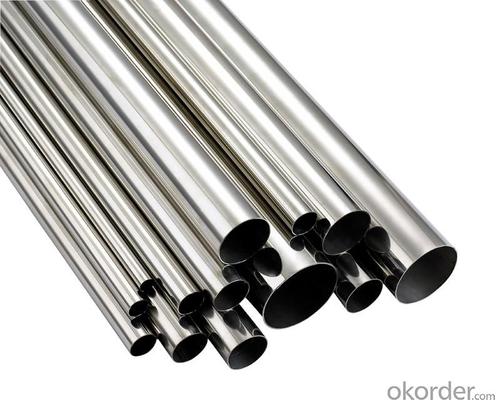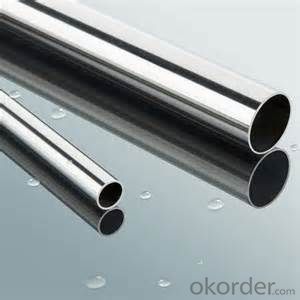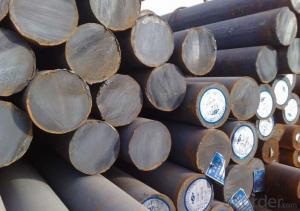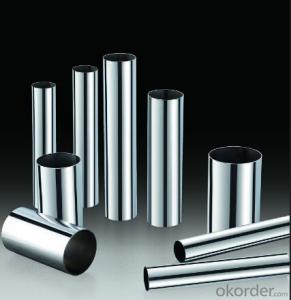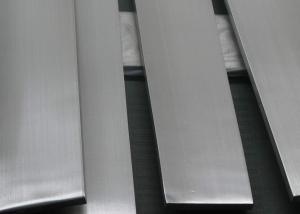STAINLESS STEEL PIPES 410material
- Loading Port:
- China Main Port
- Payment Terms:
- TT OR LC
- Min Order Qty:
- -
- Supply Capability:
- -
OKorder Service Pledge
OKorder Financial Service
You Might Also Like
Description:
Stainless Steel Pipe
Material:
304 321 316 310
Packing:
In bundle
MOQ:
5 TONS
Comparison of standardized steels
| EN-standard Steel no. k.h.s DIN | EN-standard Steel name | SAE grade | UNS |
|---|---|---|---|
| 1.4109 | X65CrMo14 | 440A | S44002 |
| 1.4112 | X90CrMoV18 | 440B | S44003 |
| 1.4125 | X105CrMo17 | 440C | S44004 |
| | | 440F | S44020 |
| 1.4016 | X6Cr17 | 430 | S43000 |
| 1.4408 | G-X 6 CrNiMo 18-10 | 316 | |
| 1.4512 | X6CrTi12 | 409 | S40900 |
| | | 410 | S41000 |
| 1.4310 | X10CrNi18-8 | 301 | S30100 |
| 1.4318 | X2CrNiN18-7 | 301LN | |
| 1.4307 | X2CrNi18-9 | 304L | S30403 |
| 1.4306 | X2CrNi19-11 | 304L | S30403 |
| 1.4311 | X2CrNiN18-10 | 304LN | S30453 |
| 1.4301 | X5CrNi18-10 | 304 | S30400 |
| 1.4948 | X6CrNi18-11 | 304H | S30409 |
| 1.4303 | X5CrNi18-12 | 305 | S30500 |
| | X5CrNi30-9 | 312 | |
| 1.4541 | X6CrNiTi18-10 | 321 | S32100 |
| 1.4878 | X12CrNiTi18-9 | 321H | S32109 |
| 1.4404 | X2CrNiMo17-12-2 | 316L | S31603 |
| 1.4401 | X5CrNiMo17-12-2 | 316 | S31600 |
| 1.4406 | X2CrNiMoN17-12-2 | 316LN | S31653 |
| 1.4432 | X2CrNiMo17-12-3 | 316L | S31603 |
| 1.4435 | X2CrNiMo18-14-3 | 316L | S31603 |
| 1.4436 | X3CrNiMo17-13-3 | 316 | S31600 |
| 1.4571 | X6CrNiMoTi17-12-2 | 316Ti | S31635 |
| 1.4429 | X2CrNiMoN17-13-3 | 316LN | S31653 |
| 1.4438 | X2CrNiMo18-15-4 | 317L | S31703 |
| 1.4362 | X2CrNi23-4 | 2304 | S32304 |
| 1.4462 | X2CrNiMoN22-5-3 | 2205 | S31803/S32205 |
| 1.4539 | X1NiCrMoCu25-20-5 | 904L | N08904 |
| 1.4529 | X1NiCrMoCuN25-20-7 | | N08926 |
| 1.4547 | X1CrNiMoCuN20-18-7 | 254SMO | S31254 |
Stainless steel’s resistance to corrosion and staining, low maintenance and familiar lustre make it an ideal material for many applications. There are over 150 grades of stainless steel, of which fifteen are most commonly used. The alloy is milled into coils, sheets, plates, bars, wire, and tubing to be used in cookware, cutlery, household hardware, surgical instruments, major appliances, industrial equipment (for example, in sugar refineries) and as an automotive and aerospace structural alloy and construction material in large buildings. Storage tanks and tankers used to transport orange juice and other food are often made of stainless steel, because of its corrosion resistance. This also influences its use in commercial kitchens and food processing plants, as it can be steam-cleaned and sterilized and does not need paint or other surface finishes.
Stainless steel is used for jewelry and watches with 316L being the type commonly used for such applications. It can be re-finished by any jeweler and will not oxidize or turn black.
Some firearms incorporate stainless steel components as an alternative to blued or parkerized steel. Some handgun models, such as the Smith & Wesson Model 60 and the Colt M1911 pistol, can be made entirely from stainless steel. This gives a high-luster finish similar in appearance to nickel plating. Unlike plating, the finish is not subject to flaking, peeling, wear-off from rubbing (as when repeatedly removed from a holster), or rust when scratched.
Architecture[edit]
Stainless steel is used for buildings for both practical and aesthetic reasons. Stainless steel was in vogue during the art deco period. The most famous example of this is the upper portion of the Chrysler Building (pictured). Some diners and fast-food restaurants use large ornamental panels and stainless fixtures and furniture. Because of the durability of the material, many of these buildings retain their original appearance.
Type 316 stainless is used on the exterior of both the Petronas Twin Towers and the Jin Mao Building, two of the world's tallest skyscrapers.[17]
The Parliament House of Australia in Canberra has a stainless steel flagpole weighing over 220 tonnes (240 short tons).
The aeration building in the Edmonton Composting Facility, the size of 14 hockey rinks, is the largest stainless steel building in North America.
Bridges[edit]
Cala Galdana Bridge in Minorca (Spain) was the first stainless steel road bridge.
Sant Fruitos Pedestrian Bridge (Catalonia, Spain), arch pedestrian bridge.
Padre Arrupe Bridge (Bilbao, Spain) links the Guggenheim museum to the University of Deusto.[18]
Monuments and sculptures[edit]
The Unisphere, constructed as the theme symbol of the 1964-5 World's Fair in New York City, is constructed of Type 304L stainless steel as a sphere with a diameter of 120 feet, or 36.57 meters.
The Gateway Arch (pictured) is clad entirely in stainless steel: 886 tons (804 metric tonnes) of 0.25 in (6.4 mm) plate, #3 finish, type 304 stainless steel.[19]
The United States Air Force Memorial has an austenitic stainless steel structural skin.
The Atomium in Brussels, Belgium was renovated with stainless-steel cladding in a renovation completed in 2006; previously the spheres and tubes of the structure were clad in aluminium.
The Cloud Gate sculpture by Anish Kapoor, in Chicago US.
The Sibelius monument in Helsinki, Finland, is made entirely of stainless steel tubes.
The Man of Steel (sculpture) under construction in Rotherham, England.
Other[edit]
- Automotive bodies
The Allegheny Ludlum Corporation worked with Ford on various concept cars with stainless steel bodies from the 1930s through the 1970s, as demonstrations of the material's potential. The 1957 and 1958 Cadillac Eldorado Brougham had a stainless steel roof. In 1981 and 1982, the DeLorean DMC-12 production automobile used stainless steel body panels over a glass-reinforced plasticmonocoque. Intercity buses made by Motor Coach Industries are partially made of stainless steel. The aft body panel of the Porsche Cayman model (2-door coupe hatchback) is made of stainless steel. It was discovered during early body prototyping that conventional steel could not be formed without cracking (due to the many curves and angles in that automobile). Thus, Porsche was forced to use stainless steel on the Cayman.
- Passenger rail cars
Rail cars have commonly been manufactured using corrugated stainless steel panels (for additional structural strength). This was particularly popular during the 1960s and 1970s, but has since declined. One notable example was the early Pioneer Zephyr. Notable former manufacturers of stainless steel rolling stock included the Budd Company (USA), which has been licensed to Japan's Tokyu Car Corporation, and the Portuguese company Sorefame. Many railcars in the United States are still manufactured with stainless steel, unlike other countries who have shifted away.
- Aircraft
Budd also built an airplane, the Budd BB-1 Pioneer, of stainless steel tube and sheet, which is on display at the Franklin Institute.
The American Fleetwings Sea Birdamphibious aircraft of 1936 was also built using a spot-welded stainless steel hull.
The Bristol Aeroplane Company built the all-stainless steel Bristol 188 high-speed research aircraft, which first flew in 1963.
The use of stainless steel in mainstream aircraft is hindered by its excessive weight compared to other materials, such as aluminum.
- Jewelry
Valadium, a stainless steel and 12% nickel alloy is used to make class and military rings. Valadium is usually silver-toned, but can be electro-charged to give it a gold tone. The gold tone variety is known as Sun-lite Valadium
- Q: What are the maintenance requirements for stainless steel pipes?
- The maintenance requirements for stainless steel pipes are relatively low compared to other materials. However, there are a few key steps that should be taken to ensure their longevity and optimal performance. Firstly, regular cleaning is essential to remove any dirt, grime, or other contaminants that may accumulate on the surface of the pipes. This can be done using mild soap and water or a non-abrasive cleaner. It is important to avoid using abrasive materials or harsh chemicals as they can damage the stainless steel surface. Secondly, it is recommended to inspect the pipes periodically to check for any signs of corrosion or damage. Stainless steel is known for its resistance to corrosion, but in certain environments or under specific conditions, it can still be susceptible to corrosion. Any signs of corrosion should be addressed promptly to prevent further deterioration. Thirdly, stainless steel pipes should be protected from physical damage or impact. This can be achieved by avoiding heavy objects from hitting or rubbing against the pipes, as well as using appropriate padding or insulation in areas where they are exposed to potential impact. Lastly, it is important to ensure that stainless steel pipes are installed and used in accordance with their intended purpose and within their specified temperature and pressure limits. This will help prevent any undue stress or strain on the pipes, which could lead to premature failure. Overall, by following these maintenance requirements, stainless steel pipes can provide long-lasting durability and performance in a wide range of applications.
- Q: How do you protect stainless steel pipes from internal corrosion?
- To safeguard stainless steel pipes from internal corrosion, one effective approach is the utilization of a corrosion inhibitor. These inhibitors, which are chemical substances, can be incorporated into the fluid that flows through the pipes. This addition creates a protective layer on the inner surface of the pipe, acting as a barrier that prevents direct contact between the corrosive agents in the fluid and the stainless steel. Multiple types of corrosion inhibitors exist, and the choice depends on the specific application and the nature of the fluid being transported. Examples include organic inhibitors, which generate a protective film on the pipe's surface, and inorganic inhibitors, which interact with the corrosive agents to form less harmful compounds. An alternative method for shielding stainless steel pipes from internal corrosion involves cathodic protection. This technique entails linking the stainless steel pipe to a sacrificial anode composed of a more reactive metal like zinc or aluminum. This connection establishes a galvanic cell, whereby the anode corrodes instead of the stainless steel pipe. By sacrificing the anode, the pipe is effectively shielded from internal corrosion. Regular maintenance and inspection are also vital in preventing internal corrosion. It is crucial to monitor the condition of the pipes, promptly identify any indications of corrosion or damage, and promptly address any issues. Flushing the pipes with clean water or suitable cleaning solutions can aid in the removal of any deposits or contaminants that might contribute to corrosion. Moreover, maintaining the proper composition and pH levels of the fluid is essential in preventing internal corrosion. In certain cases, adjusting the fluid's pH or adding corrosion inhibitors tailored to the specific fluid being transported can significantly decrease the risk of corrosion. In conclusion, the combination of corrosion inhibitors, cathodic protection, regular maintenance, and appropriate fluid management is an effective means of safeguarding stainless steel pipes from internal corrosion. This approach ensures the pipes' durability and optimal performance.
- Q: How do you prevent pressure loss in stainless steel pipes?
- To prevent pressure loss in stainless steel pipes, one can take several important steps: 1. Ensure proper pipe sizing: It is crucial to choose the appropriate diameter for the stainless steel pipe based on the system's flow rate and pressure requirements. Using pipes that are too small can result in increased pressure loss due to higher fluid velocities. 2. Reduce pipe length and bends: It is advisable to keep the stainless steel pipe as short as possible and minimize the number of bends or elbows. Lengthy pipes and multiple bends introduce friction and turbulence, which lead to pressure loss. 3. Opt for a smooth interior surface: Select stainless steel pipes with a smooth interior surface finish. This helps minimize pressure loss by reducing frictional resistance and turbulence. 4. Minimize unnecessary fittings and valves: Each fitting or valve in a stainless steel pipe system adds additional pressure loss. To maintain pressure, it is best to minimize the use of unnecessary fittings and valves, selecting those with low resistance instead. 5. Ensure proper installation: Correctly installing stainless steel pipes with proper alignment and support is crucial. Misaligned or poorly supported pipes can cause excessive stress and potential deformation, resulting in pressure loss. 6. Regular maintenance and cleaning: Periodically inspect and clean the stainless steel pipes to remove any accumulated scale, debris, or deposits. These obstructions can restrict flow and lead to pressure loss. 7. Consider flow control devices: Depending on the application, incorporating flow control devices such as flow restrictors, pressure regulators, or flow meters can help maintain optimal pressure levels in the stainless steel pipe system. By implementing these measures, one can minimize pressure loss in stainless steel pipes, ensuring efficient and effective fluid transportation within the system.
- Q: What is the difference between 347 and 347H stainless steel pipes?
- The main difference between 347 and 347H stainless steel pipes lies in their carbon content. 347 stainless steel pipes have a maximum carbon content of 0.08%, while 347H stainless steel pipes have a higher carbon content range of 0.04-0.10%. This higher carbon content in 347H pipes provides improved high-temperature strength and greater resistance to sensitization, which is the formation of chromium carbides at grain boundaries that can lead to intergranular corrosion. Due to its higher carbon content, 347H stainless steel pipes are typically recommended for applications involving elevated temperatures and thermal cycling. They offer enhanced creep resistance and can withstand higher stress levels than 347 stainless steel pipes. 347H pipes are commonly used in industries such as chemical processing, petrochemical, and power generation, where they are exposed to high temperatures and corrosive environments. In summary, the difference between 347 and 347H stainless steel pipes lies in their carbon content, with 347H pipes offering improved high-temperature strength and resistance to sensitization. The choice between the two depends on the specific application requirements and operating conditions.
- Q: Are stainless steel pipes resistant to scaling?
- Yes, stainless steel pipes are resistant to scaling. Scaling refers to the formation of a hard, thick layer of mineral deposits on the inner surface of pipes, which can reduce their efficiency and restrict the flow of fluids. Stainless steel pipes have a high resistance to scaling due to their composition, which typically includes chromium. The presence of chromium forms a protective oxide layer on the surface of the pipe, preventing the formation of scale and ensuring long-term durability. Additionally, stainless steel pipes have excellent corrosion resistance, making them suitable for a wide range of applications where scaling may occur.
- Q: How do you determine the size of a stainless steel pipe?
- To determine the size of a stainless steel pipe, there are a few key factors to consider. Firstly, you need to measure the outside diameter (OD) of the pipe. This can be done using a caliper or a tape measure. Make sure to measure across the widest point of the pipe to get an accurate reading. Next, you should determine the wall thickness of the pipe. This can be measured using a caliper or a pipe gauge. The wall thickness is crucial in determining the strength and durability of the pipe. Once you have the OD and wall thickness measurements, you can proceed to calculate the nominal pipe size (NPS) or the trade size of the stainless steel pipe. This is typically denoted in inches and represents the inner diameter (ID) of the pipe. The NPS can be determined using industry standards or pipe size charts available online. It is important to note that stainless steel pipes are commonly available in a variety of schedules, which indicate the wall thickness. These schedules range from Schedule 5S (the thinnest) to Schedule XXS (the thickest). The schedule of the pipe should be considered while determining the size, as it affects the pipe's pressure rating and suitability for specific applications. In summary, determining the size of a stainless steel pipe involves measuring the outside diameter, determining the wall thickness, and calculating the nominal pipe size based on industry standards or pipe size charts.
- Q: What is the difference between ERW and EFW stainless steel pipes?
- ERW (Electric Resistance Welded) and EFW (Electric Fusion Welded) are two different methods used for manufacturing stainless steel pipes. The main difference between the two lies in the welding process. ERW stainless steel pipes are manufactured by rolling a flat sheet of steel into a cylindrical shape and then welding the edges together using a high-frequency electrical current. This process creates a strong, seamless joint between the two edges of the sheet, resulting in a pipe that is highly resistant to corrosion and has a smooth interior surface. ERW pipes are commonly used in applications where strength and durability are required, such as in the oil and gas industry. On the other hand, EFW stainless steel pipes are made by applying a combination of heat and pressure to melt the edges of two pieces of steel and then welding them together. This fusion welding process results in a pipe that has a continuous weld along its entire length, eliminating the need for any additional welding. EFW pipes are known for their excellent corrosion resistance and are often used in applications where high-pressure and high-temperature conditions are present, such as in chemical plants and power generation facilities. In summary, the main difference between ERW and EFW stainless steel pipes lies in the welding process. ERW pipes are made by welding the edges of a flat sheet, while EFW pipes are made by fusing the edges of two pieces of steel. Both methods have their respective advantages and are used in different applications depending on the specific requirements of the project.
- Q: What is the maximum temperature limit for stainless steel pipes?
- The specific grade of stainless steel used determines the maximum temperature limit for stainless steel pipes. In general, stainless steel pipes can tolerate high temperatures ranging from 1200°F (650°C) to 1600°F (870°C). However, it is important to consider the specific alloy composition, as certain grades of stainless steel possess greater temperature resistance than others. Moreover, the maximum temperature limit can be influenced by factors such as the duration of exposure to high temperatures and the presence of corrosive substances. Therefore, consulting the manufacturer's specifications or seeking professional guidance is crucial to accurately determine the maximum temperature limit for a specific application of stainless steel pipes.
- Q: What is passivation in stainless steel pipes?
- Passivation in stainless steel pipes refers to the process of treating the surface of the pipes to remove any contaminants and enhance its corrosion resistance properties. It involves the use of chemical solutions or acids to remove iron particles and other impurities from the surface, creating a protective oxide layer that prevents further corrosion.
- Q: Can stainless steel pipes be insulated with silicone?
- Indeed, it is possible to insulate stainless steel pipes using silicone. Silicone proves to be a highly adaptable substance capable of enduring a vast spectrum of temperatures, rendering it ideal for the purpose of insulating pipes that transport either hot or cold fluids. Typically, silicone insulation is obtainable in the form of sleeves or wraps, which can be effortlessly applied to the surface of the pipe. This insulation furnishes exceptional thermal insulation, thwarting any loss or gain of heat from the pipe and thereby enhancing energy efficiency. Furthermore, silicone insulation exhibits resistance towards moisture, chemicals, and UV radiation, guaranteeing its durability and long-standing efficacy.
Send your message to us
STAINLESS STEEL PIPES 410material
- Loading Port:
- China Main Port
- Payment Terms:
- TT OR LC
- Min Order Qty:
- -
- Supply Capability:
- -
OKorder Service Pledge
OKorder Financial Service
Similar products
Hot products
Hot Searches
Related keywords

